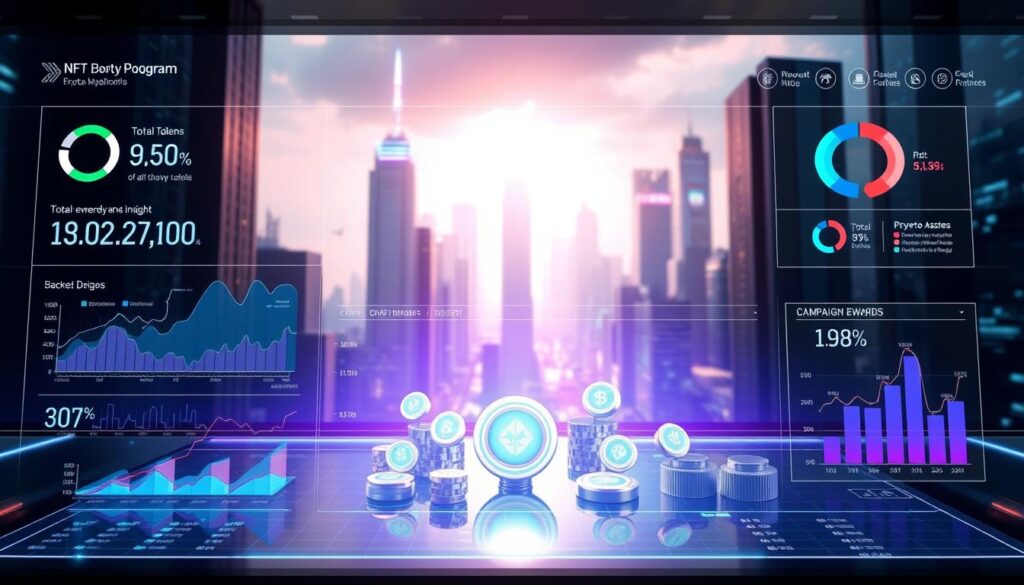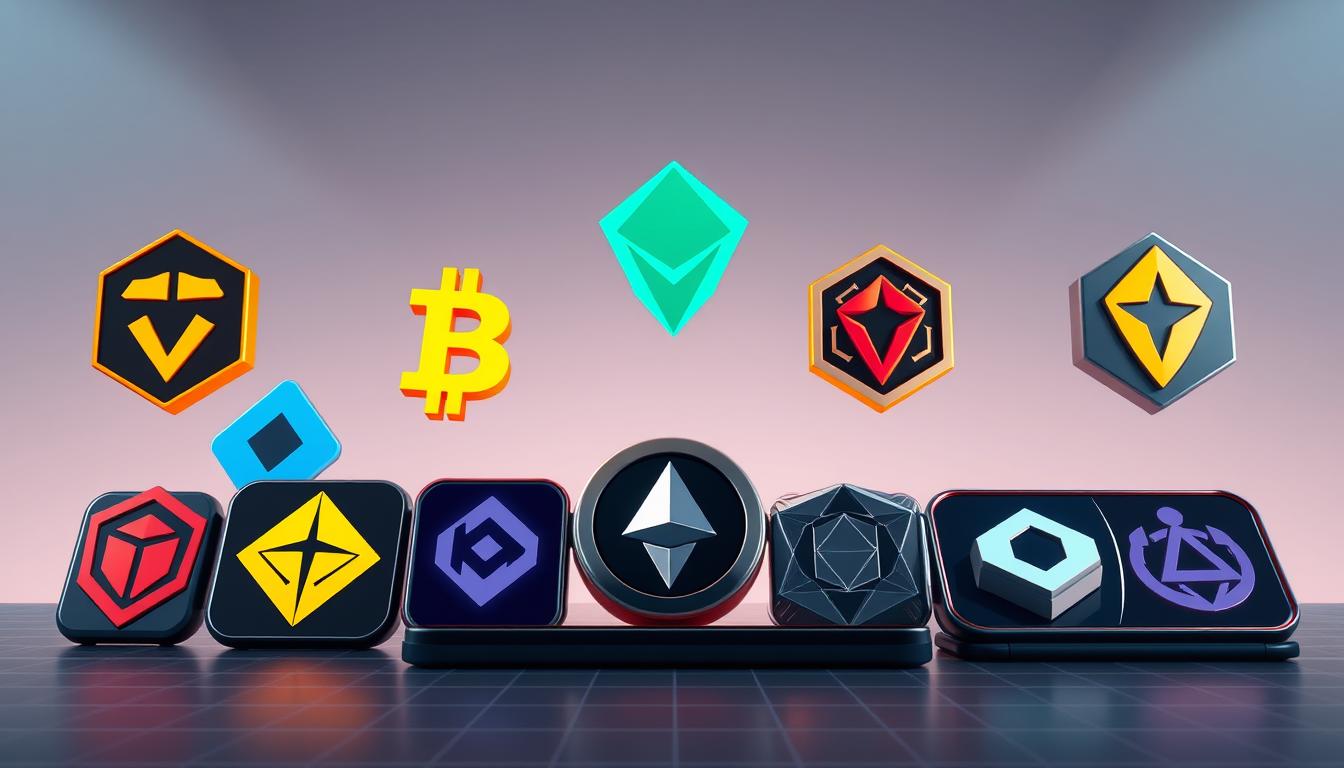Now Reading: Get Paid: NFT Bounty Programs That Pay Crypto Rewards
- 01
Get Paid: NFT Bounty Programs That Pay Crypto Rewards
Get Paid: NFT Bounty Programs That Pay Crypto Rewards

A new way to earn digital currency is here. You don’t need to invest money upfront. Instead, you can use your skills and time to participate in exciting community projects.
These initiatives represent a major shift in how blockchain projects grow. They offer real financial incentives for people who help with various tasks. This creates a more fair system for everyone involved.
The opportunities are vast. You can find roles in content creation, social media promotion, or translation work. There are also chances for technical experts to find bugs and improve security.
Rewards can be significant. Some tasks offer small amounts, while critical discoveries can lead to very large payouts. This guide will show you how to get started, from basic concepts to advanced strategies.
Key Takeaways
- Earn digital assets without making a traditional financial investment.
- Projects offer incentives for a wide range of skills, from creative to technical.
- These engagement mechanisms help distribute tokens more equitably.
- Reward amounts vary greatly, with potential for substantial earnings.
- Participation is open to both beginners and experienced enthusiasts.
- Understanding platform selection and security is crucial for success.
Introduction: Setting the Stage for Crypto Rewards
Blockchain initiatives are creating fresh pathways for global participation. These structured campaigns represent a fundamental shift in how digital asset ecosystems grow and engage supporters worldwide.
Overview of NFT Bounty Programs
These engagement systems function as organized campaigns established by emerging blockchain ventures. They aim to foster organic growth through specific task completion. Participants receive digital asset incentives for their contributions.
The decentralized nature of this approach allows projects to access talent without geographical limitations. This creates a truly international workforce supporting development. Global accessibility is a core advantage of these participation models.
Importance for the Crypto Community
These systems democratize earning opportunities for skilled individuals worldwide. Anyone with relevant abilities can participate regardless of location or background. This creates more equitable distribution of digital assets.
For new ventures, these campaigns offer affordable alternatives to traditional marketing. Startups can allocate resources toward development while achieving significant reach. The community-building aspect creates invested stakeholders who contribute real value.
Modern engagement campaigns have evolved beyond basic promotional tasks. They now include sophisticated activities like smart contract auditing and governance participation. This dual approach solves immediate needs while building long-term community foundations.
NFT bounty programs that pay crypto rewards
The landscape of blockchain participation has evolved beyond traditional investment methods to include skill-based contribution systems. These structured initiatives create mutual benefits for both participants and emerging digital ventures.
Key Components and Terminology
A digital asset incentive represents compensation offered to individuals who complete specific tasks for blockchain initiatives. These activities range from technical security audits to community engagement efforts.
Participants who actively seek these opportunities are often called contributors or hunters. They navigate structured campaigns managed by coordination professionals. Understanding these roles is essential for successful participation.
Different reward structures exist within these engagement systems. The table below outlines common compensation models:
| Reward Type | Description | Typical Use Cases | Advantages |
|---|---|---|---|
| Fixed Amount | Predetermined compensation for specific tasks | Social media promotion, content creation | Clear expectations, predictable earnings |
| Percentage-Based | Share of allocated incentive pool | Bug discovery, security audits | Scalable rewards, high potential |
| Tiered System | Compensation scales with contribution quality | Technical development, major discoveries | Merit-based, encourages excellence |
How This Guide Will Help You
This resource provides practical strategies for identifying legitimate opportunities. You’ll learn to evaluate compensation structures and assess time requirements effectively.
The guide covers essential security measures and platform selection criteria. It helps maximize earning potential while minimizing risks. For comprehensive insights into campaign mechanics, explore our detailed resource on engagement initiatives.
Subsequent sections will address participation mechanics, security considerations, and optimization approaches. This foundation prepares you for successful involvement in digital asset ecosystems.
Understanding NFT Bounty Programs
The concept of rewarding contributors for finding flaws has deep roots in the technology sector. Major companies like Google and Microsoft established formal systems to incentivize security researchers.
What They Are and How They Evolved
These initiatives began as focused security efforts in traditional software development. Companies paid external experts to identify vulnerabilities before malicious actors could exploit them.
Blockchain ventures adopted this model but expanded it dramatically. The approach now includes marketing, community growth, and content creation. This evolution reflects the decentralized nature of digital asset ecosystems.
Differentiating from Traditional Bounty Programs
Modern initiatives operate without geographical or corporate barriers. Anyone with internet access can participate regardless of location or background.
The table below highlights key differences between traditional and contemporary approaches:
| Aspect | Traditional Programs | Modern Blockchain Initiatives |
|---|---|---|
| Accessibility | Limited to approved researchers | Open to global participants |
| Reward Types | Primarily monetary payments | Digital assets and unique tokens |
| Scope | Focus on security vulnerabilities | Comprehensive project development |
| Community Role | Limited involvement | Central to project growth |
This shift creates genuine symbiotic relationships between ventures and contributors. Both parties receive tangible value through their collaboration.
The Role of Bug Bounties in Enhancing Crypto Security
In the fast-paced world of Web3, proactive security measures are not just an advantage—they are an absolute necessity. Financial incentives for discovering flaws have become a cornerstone of this defensive strategy.

How Bug Bounties Strengthen Blockchain Projects
These initiatives create a powerful, continuous review process. Hundreds of skilled researchers examine a project’s code for weaknesses.
This is especially vital for smart contracts. Once deployed, they are difficult to modify. A single vulnerability can lead to catastrophic financial losses.
This approach incentivizes ethical behavior. Experts are motivated to report issues privately for a reward, rather than exploiting them.
Examples of Successful Bug Bounty Campaigns
Platforms like Immunefi demonstrate the system’s effectiveness. They have facilitated payouts totaling hundreds of millions of dollars.
These campaigns have prevented potential losses amounting to billions. They protect decentralized finance protocols and user funds.
Rewards scale with the severity of the discovered issue. Critical flaws that threaten user assets can yield over $100,000.
Common vulnerabilities in smart contract code present significant risks. Understanding them is key to appreciating the value of these security efforts.
| Vulnerability Type | Description | Real-World Impact |
|---|---|---|
| Reentrancy Attacks | A contract interacts with an external contract before updating its own state. | Caused the 2016 DAO hack, resulting in $60 million in losses. |
| Integer Overflow/Underflow | Numbers exceed storage limits, causing unexpected behavior. | Can manipulate token balances or transaction calculations. |
| Access Control Errors | Critical functions are accidentally left open to public use. | Allows unauthorized users to perform privileged actions. |
| Flash Loan Exploits | Borrowed funds manipulate contract logic within one transaction. | Used to drain funds from vulnerable DeFi applications. |
These security initiatives work alongside formal audits. They provide an ongoing layer of protection as projects evolve and new threats emerge.
How NFT Bounty Programs Work
Engaging with these initiatives follows a clear, structured path from start to finish. Understanding this workflow is key to effective participation and maximizing your potential earnings.
Step-by-Step Process Overview
The journey begins by finding active campaigns. Participants often use specialized websites or community forums to discover opportunities.
Registration is the next critical step. This usually involves creating an account on the relevant platform and connecting a digital wallet. Some initiatives may require identity verification.
After registering, you review available tasks. You assess their requirements, difficulty, and potential compensation before selecting ones that match your skills.
Participation Mechanics and Reward Distribution
Once a task is claimed, you complete it according to the guidelines. Submissions must often include proof of work for review by campaign managers.
These managers evaluate the quality of each contribution. They ensure fairness and adherence to the campaign’s rules before approving payments.
Distribution methods vary significantly. The table below outlines common approaches used by different projects.
| Distribution Method | Description | Best For |
|---|---|---|
| Immediate Payment | Tokens are sent right after task approval. | Smaller tasks, quick turnaround |
| Vesting Schedule | Rewards are released over a set period. | Long-term alignment with project goals |
| Pool-Based Sharing | Participants receive a share of a total pool based on contribution level. | Community-driven marketing efforts |
Timing is a crucial element. Campaigns have specific start and end dates, with clear deadlines for submissions and reward distribution. For a deeper look into campaign mechanics, this explanation of crypto bounty programs offers valuable insights.
This structured approach creates a fair system for all involved. It allows participants to plan their involvement and understand exactly what to expect.
Benefits of Participating in NFT Bounty Programs
Participation in digital asset initiatives offers numerous advantages beyond immediate financial gain. These engagement systems create win-win scenarios for both contributors and emerging ventures.
Token Distribution and Community Trust
Early contributors often receive digital assets at favorable rates. This creates potential for significant appreciation as ventures grow.
Trust develops naturally through transparent collaboration. Contributors become invested stakeholders rather than passive observers.
This bidirectional relationship strengthens project foundations. Active participants provide valuable feedback while building loyalty.
Economic and Engagement Advantages
These systems offer flexible entry points regardless of location or capital. People can contribute based on their skills and availability.
Skill development occurs through practical experience. Participants learn about blockchain technology while earning compensation.
Networking opportunities emerge from active community involvement. Reputation building can lead to future collaborations.
The learning-by-doing approach provides hands-on experience with digital wallets and transactions. This knowledge has lasting value beyond immediate returns.
Step-by-Step Guide to Starting Your NFT Bounty Journey
Your journey into participation campaigns begins with proper setup and research. This practical guide helps newcomers take their first steps confidently.
Establishing a secure foundation ensures safe and successful involvement. The right preparation removes barriers to entry.
Preparing Your Crypto Wallet and Tools
Begin by setting up a digital wallet to receive compensation. Beginner-friendly options include MetaMask, Trust Wallet, and Coinbase Wallet.
Security fundamentals are critical for protecting your assets. Always store seed phrases securely and enable two-factor authentication.
Consider hardware wallets for significant holdings. Learn to recognize phishing attempts to avoid scams.
Finding the Right Projects and Platforms
Create accounts on established platforms like Bounty0x, Immunefi, and Gitcoin. Specialized forums also host regular campaigns.
Evaluate venture legitimacy before investing time. Research team credentials and review project documentation thoroughly.
Look for clear task definitions and reasonable timelines. Responsive teams indicate quality opportunities.
Start with well-established platforms before exploring newer options. Verify payment histories and read community feedback carefully.
Top Platforms and Tools for Running Successful Bounty Campaigns
The digital ecosystem offers various specialized environments that connect contributors with opportunities. These environments provide structured frameworks for task management and compensation distribution. Selecting the right tools significantly impacts your engagement effectiveness.

Different platforms cater to specific needs within the blockchain space. Understanding their unique features helps you choose the most suitable options.
Bounty Platforms and Social Media Channels
Bounty0x operates as a decentralized environment connecting ventures with skilled individuals. It supports diverse campaign types through transparent smart contract systems.
Immunefi stands as the leading security-focused platform. It has facilitated substantial payouts for identifying vulnerabilities in smart contracts.
HackenProof serves as another trusted security environment. It collaborates with DeFi teams and digital asset exchanges to enhance protection.
Traditional forums like Bitcointalk remain essential community hubs. Projects announce campaigns in dedicated sections where participants discuss requirements.
Social media management utilities like Hootsuite streamline promotional tasks. They enable efficient scheduling and performance tracking for marketing campaigns.
Useful Tools for Bug Tracking and Community Engagement
GitHub provides critical infrastructure for technical contributors. It supports code review, issue reporting, and collaborative debugging processes.
Translation management systems like Crowdin simplify localization efforts. They organize multilingual content for whitepapers and documentation.
Communication platforms including Telegram and Discord facilitate real-time community interaction. These tools help participants stay informed about project developments.
Additional utilities include portfolio trackers and analytics software. They help manage earned digital assets and measure campaign impact effectively.
Smart Contract Considerations & Security Measures in Crypto
Smart contract vulnerabilities can lead to catastrophic financial losses, making security research a high-stakes endeavor. Once deployed, these contracts are difficult to modify, and a single flaw can result in irreversible damage.
Common Vulnerabilities in Smart Contracts
Reentrancy attacks remain one of the most dangerous threats. This occurs when a contract calls external code before updating its internal state. The infamous 2016 DAO hack exploited this vulnerability, draining $60 million.
Integer overflow and underflow issues arise when mathematical operations exceed variable limits. Attackers can manipulate balances or bypass restrictions through these unexpected behaviors.
Access control errors happen when administrative functions are accidentally left public. Unauthorized users gain the ability to execute privileged operations.
Flash loan attacks use borrowed funds to manipulate contract states within single transactions. This DeFi-specific threat allows instant profit-taking before loan repayment.
Best Practices for Secure Bounty Participation
Always review smart contract code thoroughly before interaction. Use separate wallets for different activities to minimize risk exposure.
Start with small test transactions to verify contract behavior. Check token contract legitimacy against official sources to avoid scams.
Understand approval permissions and be cautious of phishing attempts. For significant holdings, hardware wallets provide enhanced protection.
Automated tools can identify basic patterns, but human researchers remain essential. Creative thinking helps uncover sophisticated flaws that scanners might miss.
Measuring the Impact of Your NFT Bounty Campaigns
Successfully managing an incentive campaign requires moving beyond simple participation counts to meaningful impact analysis. This process turns raw data into actionable insights for future initiatives.
Establishing clear key performance indicators before launch is essential. These metrics provide a framework for evaluating success and guiding strategic decisions.

Key Metrics and Performance Indicators
Participation rate offers a primary gauge of campaign attractiveness. High numbers suggest effective outreach and appealing compensation.
Assessing submission quality ensures rewards match actual value. This can involve expert review or peer evaluation systems.
For promotional tasks, track social media impressions and engagement rates. Community growth in channels like Telegram provides another vital signal.
Analyzing User Engagement and Return on Investment
Calculating return involves comparing distributed asset value against achieved outcomes. These include security improvements or marketing reach.
Gathering participant feedback is critical for refinement. Post-campaign surveys reveal what worked and what needs adjustment.
Establish baseline metrics before starting. Implement tracking during the initiative for real-time insights. Thorough post-campaign analysis informs future planning.
Advanced techniques like cohort analysis track long-term contributor engagement. This helps identify your most valuable participants.
Overcoming Common Challenges in Crypto Bounty Programs
Both project teams and individual contributors face distinctive hurdles when coordinating collaborative digital initiatives. These obstacles span technical, regulatory, and operational domains.
Technical and Regulatory Hurdles
Blockchain scalability issues often create high transaction fees that impact reward distribution. Smart contract bugs in compensation systems can delay payments significantly.
Wallet compatibility problems prevent participants from claiming their earnings. These technical challenges require careful planning and testing.
Regulatory compliance presents another major hurdle. International classifications of digital assets vary widely, creating complex tax obligations.
Projects must navigate securities laws and reporting requirements across different jurisdictions. This regulatory landscape demands specialized legal expertise.
Strategies for Risk Management and Continuous Improvement
Effective risk management begins with thorough project vetting. Participants should research team credentials and review documentation carefully.
Quality control measures help prevent spam submissions and plagiarized content. Verification systems ensure legitimate contributions receive proper recognition.
Professional campaign managers play a crucial role in overcoming these challenges. They possess strong communication and organizational skills essential for success.
| Risk Category | Prevention Strategy | Mitigation Approach |
|---|---|---|
| Technical Failures | Smart contract audits before deployment | Backup distribution mechanisms |
| Regulatory Compliance | Legal consultation during planning | Clear participant guidelines |
| Quality Control | Submission verification systems | Expert review panels |
| Communication Barriers | Multilingual documentation | Dedicated support channels |
Continuous improvement involves systematic feedback collection and relationship building with standout contributors. Post-campaign analysis identifies areas for refinement in future initiatives.
Emerging Trends and Innovations in NFT & Crypto Rewards
The digital asset ecosystem is undergoing rapid transformation, introducing sophisticated engagement models. These new developments move beyond basic task completion to create deeper, more valuable interactions.
Campaigns are evolving to focus on measurable outcomes and genuine project enhancement. This shift fosters a stronger symbiotic relationship between ventures and their communities.

New Developments in the NFT Space
Gamification is a major innovation. Projects now implement achievement systems and leaderboards. This increases participant engagement and encourages long-term involvement.
Artificial intelligence tools automate submission reviews. They detect duplicate work and provide instant feedback. This improves efficiency for managers and contributors.
Cross-chain functionality is becoming standard. Participants can complete tasks across different blockchain networks. Rewards can be claimed on multiple platforms for a seamless experience.
Decentralized autonomous organizations (DAOs) are increasingly managing these initiatives. Community governance determines reward allocations and task priorities.
Verification systems have also advanced significantly. The table below contrasts old and new methods for ensuring contribution authenticity.
| Aspect | Traditional Verification | Modern Blockchain Solutions |
|---|---|---|
| Identity Proof | Centralized platform accounts | Decentralized identity (DID) protocols |
| Fraud Prevention | Manual review and basic checks | Zero-knowledge proofs and smart contract logic |
| Privacy Level | Low – requires personal data sharing | High – minimal data exposure needed |
These innovations point toward a more professional landscape. Contributing is becoming a recognized career path with specialized skill development.
This professionalization trend creates clear pathways from community contributor to core team member. The entire space benefits from this increased dedication and expertise.
Legal & Tax Implications for Crypto Reward Earners
Understanding legal frameworks is essential for individuals earning digital currency through community contributions. Proper compliance ensures long-term success while avoiding regulatory issues.
Understanding U.S. Regulations
In the United States, virtual currency received through incentive systems counts as taxable income. The IRS treats these earnings at their fair market value on receipt date.
Different tax rates apply to income recognition versus capital gains. You pay income tax when receiving tokens and capital gains tax when selling them later.
Best Practices for Record-Keeping and Reporting
Maintain detailed logs of all participation activities. Document token receipt dates, values, and project correspondence carefully.
Tracking cost basis is crucial for accurate gain calculations. Use specialized software and consult professionals for complex situations.
Different jurisdictions classify digital assets under various frameworks. The table below shows common tax treatment approaches:
| Classification Type | Tax Treatment | Reporting Requirements |
|---|---|---|
| Income | Taxed at ordinary rates upon receipt | Form 1040 Schedule 1 |
| Property | Capital gains rules apply upon disposal | Form 8949 for sales |
| Securities | Subject to investment property rules | Additional disclosure forms |
Stay current with evolving regulations as governments refine their approaches. International considerations may create additional reporting obligations.
Conclusion
Global accessibility combined with merit-based compensation has democratized earning opportunities in the digital space. These engagement systems create mutual benefits for both participants and emerging ventures.
Individuals develop valuable skills while contributing to project growth. This guide demonstrates how community-driven initiatives build stronger ecosystems.
Security-focused contributions protect user funds and create career pathways. The model continues evolving with sophisticated verification methods.
Start your journey by researching reputable platforms and matching tasks to your skills. Continuous learning and proper security measures ensure successful participation in this transformative space.
FAQ
What is the main difference between an NFT bounty program and a traditional software bug bounty?
The key difference lies in the reward structure. Traditional programs often offer cash or internal credit. NFT bounty programs reward participants with cryptocurrency or unique digital assets. This approach helps build community and directly engages users in the blockchain ecosystem.
How do I know if a bounty project is legitimate and not a scam?
Always research the project’s team, smart contract code, and community presence. Legitimate projects have transparent development teams, audited contracts on platforms like Etherscan, and active discussions on official channels like Discord or Telegram. Avoid programs that demand an upfront investment.
What skills are most valuable for participating in these programs?
Strong skills in software development, particularly in smart contract security, are highly sought after. However, non-technical roles like content creation, social media marketing, and translation are also common. Community management and design skills can be valuable for certain campaigns.
Are the crypto rewards from these programs considered taxable income?
In the United States, the IRS generally views cryptocurrency earned from bounty programs as taxable income. You must report the fair market value of the tokens at the time you receive them. It’s crucial to maintain detailed records of all rewards for accurate tax reporting.
What are the biggest risks involved in participating?
The primary risks include exposure to poorly written smart contracts that could lead to loss of funds, investing time in a project that fails, and the volatility of cryptocurrency prices. Always prioritize security by using a dedicated wallet and never sharing private keys.
Can I participate if I’m new to the cryptocurrency space?
Absolutely. Many projects have tasks designed for beginners, such as social media sharing or simple content creation. This is a great way to learn about blockchain technology, earn your first digital assets, and become part of a community while you develop more advanced skills.












